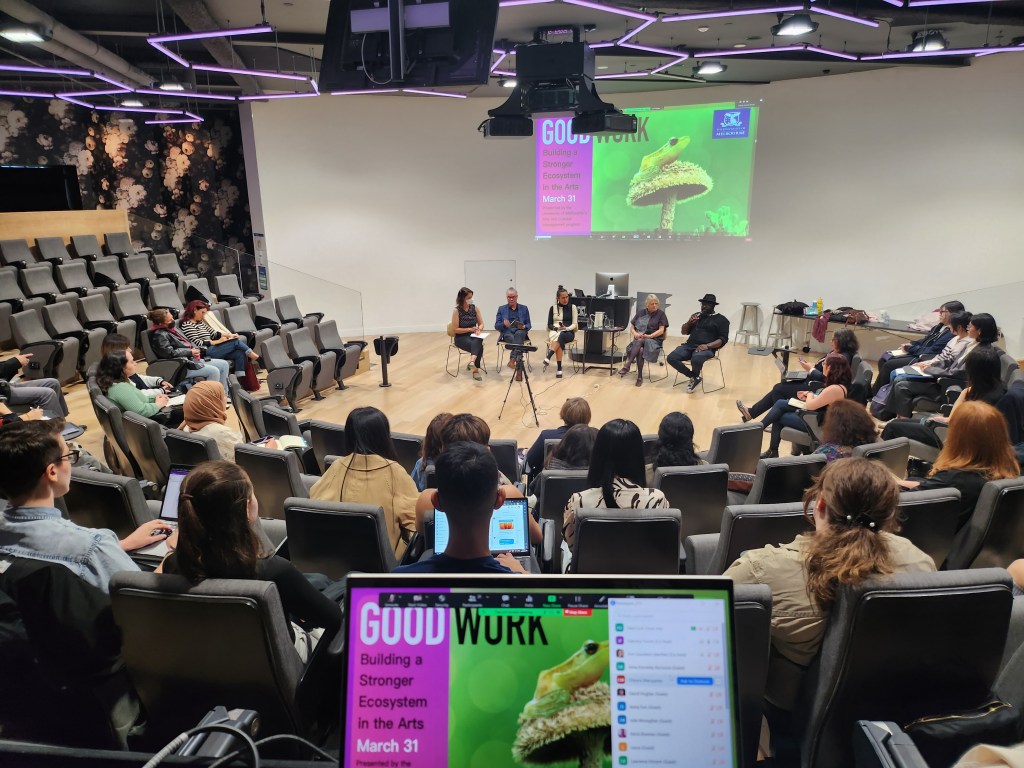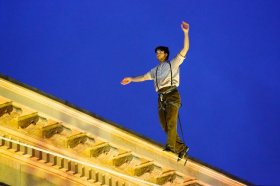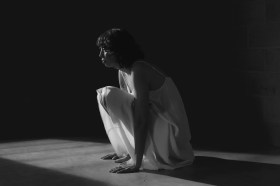When Prime Minister Albanese and Arts Minister Burke formally launched Revive in January, it was the first National Cultural Policy in a decade. The Australian arts community responded with relief and hope – and not just because of the promise of $286 million, but because the policy acknowledged the interconnectedness of the many creative sectors.
Revive framed the arts as a diverse collection of artists, arts workers, institutions, organisations, and audiences, all interacting and contributing to the broader culture, all embedded within their particular communities. In addition, the new National Cultural Policy acknowledged that serious rebuilding was necessary after years of neglect, de-funding and outright disrespect.
Beyond policy, however, there is the question: how do we, as artists, arts workers, institutions and communities, actually go about rebuilding and maintaining a healthier arts ecosystem? What does ‘health’ even look like when we’re talking about an arts ecology?
This question was the prompt behind an enlivening industry forum run by the University of Melbourne’s Arts and Cultural Management Program, held on Friday 31 March at the Parkville campus.
Speaking on the panel were four passionate and innovative arts leaders:
- Liz Jones AO, CEO and Artistic Director of La Mama Theatre since 1976 and that very day retiring;
- Seb Chan, Director and CEO at the Australian Centre for the Moving Image and the National President of the Australian Museums and Galleries Association;
- Dewi Cooke, CEO of The Social Studio, a not-for-profit social enterprise providing education and work opportunities in fashion and the creative industries to people from refugee and new migrant backgrounds; and
- and Zii Nzira, the Interim Co-CEO of Multicultural Arts Victoria and also a musician and member of Black Music Alliance Australia and Creative Victoria’s Respectful and Mentally Healthy Workplaces Working Group.
Moderating the panel was Dr Caitlin Vincent, former professional opera singer and now Head of the Arts and Cultural Management program at the University of Melbourne.
Vincent began with a blue sky question to the panellists: What is the ideal that we are aiming for? What does a healthy arts ecosystem even look like?
What is a healthy arts ecosystem?
Liz Jones began the discussion by reading a quote from legendary former PM, Gough Whitlam, whose vision and cultural policy began a renaissance in the Australian arts. Whitlam acknowledged not only excellence, but everyday participation for the sake of art itself.
‘A healthy artistic climate does not depend solely on the work of a handful of supremely gifted individuals. It demands the cultivation of talent and ability at all levels. It demands that everyday work, run-of-the-mill work, esoteric and unpopular work should be given a chance; not so much in the hope that genius may one day spring from it, but because, for those who make the arts their life and work, even modest accomplishment is an end in itself and a value worth encouraging. The pursuit of excellence is a proper goal, but it is not the race itself.’
Gough Whitlam, Prime Minister of Australia, 1972-1975.
Asked about his role with Multicultural Arts Victoria, the Zimbabwe-born Zii Nzira began by acknowledging that he came from ‘…a long line of businessmen, strategists and entrepreneurs … all the way back to the 14th century’. He said that it was important for all of us to acknowledge our individual histories, including the histories of colonisation, and he urged us to challenge a monolithic view of what ‘the arts’ are.
‘When I look at an ideal arts ecosystem, acknowledging the global majority communities, I see it as something that acknowledges the multiple ideologies of how the world looks and how it’s shaped. We should not all be forced into one particular culture. We should not be forced into one political ideology. But instead, we should all be able to express ourselves through our historical and cultural heritage, and engage with art based on that context.
‘What does that mean? In some cultures, art is very, very present in their ritual practices. And so it has a very, very strong spiritual meaning. And it’s not a commodity, it’s not something that you sell. It’s something that you access as a community … as a collective of human beings. In other communities, art is a form of identity and expression… So in my view, the long and short of an [ideal] ecosystem, from our perspective, is one that acknowledges the intrinsic value of art, before we access the financial and economic benefits of it.’
Dewi Cooke wanted to emphasise that the Social Studio, of which she is CEO, is a not-for-profit venture that very often looks like a no profit venture, and that commercialism in the arts makes such ventures perilous, but also necessary.
‘What we’re really trying to do is prioritise community and social impact,’ said Cooke. ‘When we talk about what our ideal is, we’re really looking to invert what we see as the dominant structures around who can access the arts, who has the right to be in a museum, who has the right to have their work exhibited, and who has the right to call themselves an artist or to be paid within the arts ecology, and really trying to bring as many people who aren’t from typical pathways that you might see [from] universities like this one, or other universities, or other practice streams, and give them the opportunities that everybody else from the dominant culture seems to have.’
Read: Revive: $286 million National Cultural Policy Revealed
Cooke also wanted to make the point that the arts ecosystem is far from a unified organism. A city like Melbourne, for instance, contains multiple ecosystems in various suburbs and with young people and cultural groups creating art for themselves without necessarily having any particular interest in penetrating the bigger institutions.
‘I think that’s a really beautiful and very special thing that top level arts administration needs to be really cognisant of: that there are now audiences and practitioners emerging who don’t really want to be part of that mainstream art, or maybe they do, but they want to do it on their terms. And they are, in fact, creating their own worlds and perhaps ecosystems that are hyperlocal and geographically-based. And I think that that’s something that’s really exciting, if we think about what an arts ecosystem could and should be.’
Green frogs, dinosaurs and alpha predators
Pictured on the screen behind the panel was an iridescent green frog sitting atop a mushroom. The idea of the arts as an ecosystem gave rise to talk of dinosaurs and alpha predators – powerful arts institutions that gobble up resources and attention, at the expense of smaller players like sole artists and community-run co-ops.
Vincent joked that she could see the NGV as a Tyrannosaurus Rex, while Jones said the tiny but hardy La Mama was something of a ‘bottom feeder’, though all the more important for that role, not just as an incubator of megastar talent like Cate Blanchett and David Williamson. Cooke said that, in power terms, the Social Studio was the primordial sludge. She said she worried for all those tiny solo artists whose scramble for the smallest of resources was truly humbling.

The question was posed: What are the responsibilities of dominant species (like ACMI or the big festivals, for instance) towards those institutions less powerful and less resourced? Vincent mentioned the recent controversy around the Melbourne Writers’ Festival’s date change, which clashed with the regional Bendigo Writers’ Festival, asking ACMI’s Seb Chan whether larger organisations had a responsibility to smaller ones, and to the sector at large?
‘When they take public money, they definitely do,’ said Chan, adding that they must be conscious about their impact on public policy and the broader cultural landscape. One of the roles of good public policy, whether that was state-based or decentralised, said Chan, was ‘to manage dominant species and predators’.
‘I do think that it’s really important that the larger organisations, particularly as we’re emerging from what has been some years of austerity and the pandemic, don’t cannibalise each other in order to benefit, and it’s very easy for that to happen, without … malicious intent.’
Chan went on to say that in public policy there are ‘ideas around theories of change models where you look at a system, and you look at what interventions institutions or public policy can make in order to create particular effects. We see this in economics a lot, we see this in mining and other extractive economic systems. But we don’t often think of that necessarily in terms of arts and culture.’
The ideal, of course, would be for those with power to consciously help those with less, whether that is by powerful players sitting on boards of smaller bodies, assisting with mentoring, or sharing physical resources. Individual artists could also contribute and become involved with alpha institutions by sitting on boards and actively participating in governance and policy.
Read: Access Rights in the arts: a shared responsibility
Chan said it is important to identify where the dominant species may be, and whether those dominant species need to consume other things in order to survive, and whether that’s a desirable thing. ‘I don’t think it is, but also coming out of this very subcultural and niche music space, I’m also hyper-aware that small communities of practitioners who perform only for audiences of other practitioners is not sustainable.’
Chan also raised the idea that cultural practice includes the diverse and increasingly technologically mediated ways people access and consume culture (or ‘content’ to use a word he hates). He said that increased access and availability, as with a music platform like Spotify, can ‘flatten things out’. Easier and cheaper access does not necessarily lead to enriching artists or building up creative ecosystems.
Zii Nzira gave the example of his own experience with Spotify, where he released a song in 2015.
‘I got 10,000 plays on Spotify. I thought, “I’m rich, this is it. I’ve made it.” I only got nine cents from those 10,000 plays! In my ideal world, artists become the central piece of society, because we are the ones that shape and create the world that we’re living in. But in the context of today, we’re at the bottom of the food chain, unfortunately.
‘Why don’t artists have a minimum pay? We don’t even have a union to be able to support us. We internally have arguments because we have limited resources. So we’re fighting for the scraps most of the time. Coming from an African family, as soon as you mention that you’re an artist, psychologically you’re [seen as] poor.’
Yet as Nzira pointed out, every piece of the designed world, right down to the glasses we wear on our faces, is created by an ‘artistic viewpoint’. His admonition was inspiring: that every single person ‘wake up’, fight back and ‘take back our conscious realisation that we do have the power of being creative’.
Diversity: the rhetoric and the reality
Despite the ubiquitous rhetoric around diversity and the amplification of underrepresented voices, the reality in the arts, especially at an executive and board level, is still largely ‘pale and male’. Vincent mentioned a study suggesting only 10% of the people who work in the arts industry come from diverse backgrounds, while Nzira referenced a report that only 50% of organisations that speak to advocating for increased diversity in the arts actually have it on their boards.
Nzira spoke about his own experience as an artist who became involved with the board of Multicultural Arts Victoria, and then went on to become co-CEO, and, as far as he’s aware, still the only Black person in an executive role in the arts industry.
Nzira’s experience of very often being the only Black person in the room, or on a board, was illuminating and disturbing, especially when he detailed the condescension and assumptions that are made about him, and the pressures that are put upon him to ‘represent’, often at the expense of his own sense of safety and mental health. He said this was one of the reasons he chose to be co-CEO.
‘The demands of being the only person who looks like me in these powerful positions was overbearing, and that’s that’s that’s one of the motivations between behind me going, “I don’t have the capacity to carry all of this on my own.”‘
‘I’ve had a lot of invites to panel discussions and be in a room of senior executive people within the arts industry… When I’m in a roomful of middle aged white men, I become uncomfortable. So I’m never able to actually show up as fluidly as I would like to.’
‘In terms of the structural change, internally, there is a culture that we’ve inherited. … It takes a lot of energy. So there is that balance where the culture is something that needs to change. But we also have to acknowledge that, like you said, we’re in a point of transition.’
Creating safe spaces
Creating cultural safety and safe spaces for those not traditionally supported in the arts was raised as an essential ingredient in supporting diversity and thereby building a stronger creative ecology. Jones mentioned La Mama as a theatre space that had displayed the Aboriginal flag, long before other institutions did it as a matter of course.
‘I remember David Milroy, who’s an Aboriginal leader from Western Australia … saying, “Look, I was a rock musician. I’m in theatre now. And I came into theatre, because I discovered it was a safe place.” It’s so important for organisations to create safe places where people from anywhere, from all diverse countries, can come. There are strategies that you can develop to empower people.’
Cooke said that on the point of hiring for diversity, all arts organisations need to do a lot better. She said this could be done by trying harder in recruitment, and having better community-based contacts.
‘When we hire at the Social Studio, we’re 70% culturally and linguistically diverse, 40% from refugee and asylum seeker backgrounds. And so when I hire, I don’t just put it on Seek – I almost never advertise on Seek – I go to community organisations in the target groups that we’re looking to hire within, to sort of seed the information out there. We’re talking to people all the time, keeping people’s resumes on file who maybe weren’t the right fit for one role, that we can come back to [later]. I think that’s incumbent on any kind of organisation and leadership.’
Cooke said that although the Social Studio did not have any trans staff members, they were working with a group of young transgender, diverse asylum seekers at the moment, ‘really trying to figure out a way that we can support them, and trying to tailor something for them, in consultation with them.
‘And I think that ultimately comes down to that’s the best we can do: to interact with people as human beings.’
Ideas for the future
Connecting on a human level, and the core concepts of care, respect and safety were key for all the panellists. Looking after each other while also supporting rigour and excellence in the necessarily elite arenas is part of the challenge for good policy and sound funding decisions.
Breaking down barriers between siloed groups and organisations was also seen as a way forwards to a healthier arts ecology.
Nzira gave the example of local council arts organisations that offer grants and residencies to community artists or collectives, but after these have run their course, these people disappear back into the community. He is working towards a concept where councils could collaborate and share in order to extend the support and exposure of these artists.
Looking to the future, Seb Chan said he was excited by the collapsing of borders and barriers to creativity, and that the next generation integrated creative practice into their everyday lives in ways previous generations did not. He said that 73% of ACMI’s visitors were under 35 (excluding school kids) and that this next generation of people may not want to have a full-time creative career, ‘but inevitably will be creative in anything they do’.
‘We can’t keep pulling things out of the ground. There’s an economy anyway, so most of our economic futures will lie, with a population of our size, in creative practices of some sort… And that’s where the beauty of stuff is. And that’s also where identities blur, and content contexts blur, and we can live collectively together in a future system that is less about the exercising of power to exclude each other.’





